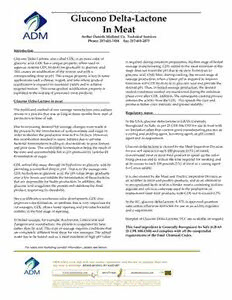
Glucono Delta-Lactone In Meat PDF
Preview Glucono Delta-Lactone In Meat
___ __________________________________ ________ Glucono Delta-Lactone In Meat Archer Daniels Midland Co. Technical Services Phone: 217-451-7418 Fax: 217-451-2473 Introduction Glucono Delta-Lactone, also called GDL, is an inner ester of is required during emulsion preparation, the first stage of boiled gluconic acid. GDL has a unique property; when used in aqueous systems GDL hydrolyzes gradually to gluconic acid. sausage manufacturing. GDL added to the meat emulsion at this This causes an acidification of the system and with a stage does not lower the pH due to its slow hydrolysis to corresponding drop in pH. This unique property is key in some gluconic acid. Only later, during cooking, the second stage of applications such a cheese, yogurt, and tofu where gradual sausage production, when a lower pH is required to improve formation will GDL hydrolyze to gluconic acid and provide the acidification is required to maximize yields and to achieve targeted texture. This same gradual acidification property is desired pH. Thus, in boiled sausage production, the desired exploited in the making of processed meat products. neutral conditions needed are maintained during the emulsion phase even after GDL addition. The subsequent cooking process Glucono Delta-Lactone in meat r e l e a s e s t h e a c i d i t y f r o m t h e G D L . T h i s s p e e d s t h e c u r e a n d produces better color intensity and greater stability. The traditional method of raw sausage manufacture uses sodium nitrate in a process that was as long as three months from start of Regulatory status production to time of sale. In the USA, glucono delta-lactone is GRAS, Generally Recognized As Safe, as per 21 CFR 184.1318 for use in food with Due to increasing demand for sausage, changes were made in no limitation other than current good manufacturing practice as the process by the introduction of sodium nitrate and sugar in a curing and pickling agent, leavening agent; as pH control order to shorten the production time to 8 to 14 days. However, agent and as sequestrant. this modification resulted in many failures due to adverse bacterial fermentations leading to discoloration, to poor texture Glucono delta-lactone is cleared by the Meat Inspection Division and poor taste. This undesirable fermentation being the result of for use at 8 ounces for each 100 pounds (0.5%) of cured, the slow and uncontrollable fall in pH produced by lactobacilli comminuted meat or meat food product to speed up the color- fermentation of sugar. fixing process and to reduce the time required for smoking and at 16 ounces to each 100 pounds (1%) of meat as a curing agent GDL solved this issue, through its hydrolysis to gluconic acid by for Genoa salami. providing a controlled drop in pH. That is in the sausage mix GDL hydrolyses to gluconic acid, the pH value drops gradually It is also cleared by the Meat and Poultry Inspection Division as over a few hours and inhibits the fermentation of those bacteria an acidifier in meat and poultry products, and as an alternative that are responsible for faulty production. In addition, the to encapsulated lactic acid in a binder matrix containing sodium gluconic acid coagulates the protein and stabilizes the final alginate and calcium carbonate used in the production of product, improving its sliceability. restructured meat food products, with GDL not to exceed 0.3%. Since acidification accelerates color development, GDL also In the EC, glucono delta-lactone, E 575, is approved quantum improves color formation, an attribute that is very important for satis unless otherwise restricted for use as an acidity regulator cut sausages. GDL allows faster ripening and provides bacterial and a sequestrant. stability in the first stage of ripening. Samples of Glucono Delta-Lactone, FCC are available on request. In boiled sausage, for example, Kochwurst, Leberwurst and Zungenwurst manufacture, the protein is coagulated by heat This food ingredient is Generally Recognized As Safe (GRAS rather than by acid. This type of sausage requires conditions that 21 CFR 184.1318) and complies with all the compendial are completely different from those for raw sausages. The added requirements of the Food Chemical Codex. water has to be bound and so a meat emulsion of high pH value
